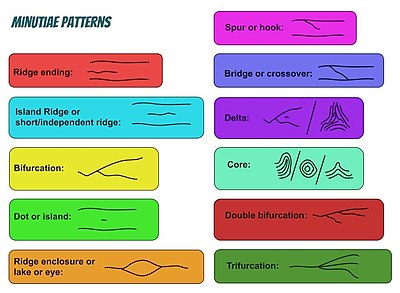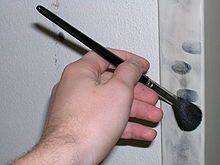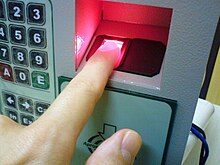fingerprint
The fingerprint or the dactylogram ( old Gr. Δάκτυλος dáktylos "finger") is an imprint of the papillary ridges on the underside of the fingertip (end member of a finger , also fingertip). Earlier, the names were edge index , Tastrosette , Tastfigur or Tastwärzchenlinie usual.
So far, no two people are known to have the same fingerprint, and it is assumed that the fingerprint is unique . Even identical twins have different fingerprints, because the development of the papillary ridges is an embryonic process during the growth of the fingers, which is influenced by many factors and each leads to different results.
In very rare cases, as a result of a genetic defect, the fingers are missing the papillary ridges so that they do not leave a fingerprint ( vein dermatoglyphy ).
history
In Nineveh in the Assyrian Empire , cuneiform tablets were found on which not only the name of the author was noted, but also an impression of the fingertip to the fingernail. Further fingerprints could be extracted with the GigaMesh software framework from clay tablets of the Uruk-Warka Collection Heidelberg from high-resolution 3D models. In the empire of China and oriental countries, fingerprints were used early on to sign passports , promissory notes and similar documents . In China, use has been documented by the Yung-Hwui law since the 7th century at the latest. In Germany, the anthropologist H. Welker from Gießen was the first to deal with fingerprints in 1856; he made pictures of the papillary lines by coloring his hand and printing them on paper.
In 1892, a murder, a double child murder by their mother, was solved for the first time in Argentina , purely on the basis of a fingerprint. Ten years later, France succeeded for the first time in Europe to solve a murder using fingerprints, of all people, by an opponent of the new method of dactyloscopy, Alphonse Bertillon . In the theft of the Mona Lisa in 1911, in which a left thumbprint secured on the protective glass case of the picture had not been compared with the existing anthropometric map of the perpetrator, an investigation would have been possible quickly, but possibly also not because the police chief was still Alphonse Bertillon was. In 1912 the first criminal was convicted in Switzerland purely on the basis of his prints.
After the end of the Second World War, the FBI's card index comprised 100 million cards, since not only criminals but also employees of the defense industry and other military and civilians as well as foreigners were recorded. Many people gave their fingerprints voluntarily, and by 1960 there were 160 million ten-finger prints, and by 1964 172 million. In contrast, the collection of the Federal Criminal Police Office in Wiesbaden only contained 1.1 million people in 1960.
features
From a biological point of view, a papillary ridge is an elevation of the epidermis on the palmar or plantar skin, i.e. the palm or the sole of the foot. Within these, various features of the fingerprint that can be determined according to the Henry classification system are distinguished:
- Basic pattern
- gross features: (left and right) loop, (tense) arch, vertebra
- finer characteristics: minutiae
- Pore structure
The endings and branches of the papillary ridges of the human fingerprint are referred to as minutiae ( lat. Minutus = "little thing"). In addition, “papillary line end, single bifurcation, double bifurcation, triple bifurcation ((trifurcation)), single vertebra, double vertebra, side contact; Hook, point, interval, X-line, single bridge, double bridge and continuous line "() differentiated. Based on these features and their distribution within a fingerprint, a unique distinguishability can be guaranteed.
Criminology
In criminology , it is checked at the scene of the crime whether fingerprints can be found ( dactyloscopy ). Fingerprints found are compared with a database to identify possible suspects. The German Federal Criminal Police Office maintains an AFIS database with the fingerprints of over three million people. The comparison of fingerprints with large amounts of data only became possible with the advent of powerful computers and precise mathematical descriptions of the properties of a fingerprint.
The English natural scientist Francis Galton and the Argentine criminologist Juan Vucetich are considered to be the inventors of the identification of people through fingerprints . The securing of fingerprints with the help of the so-called "lacquer film method" goes back to the geologist Ehrhard Voigt , who invented it around 1930 in order to preserve soil and sediment profiles.
The use of fingerprints in criminology is sometimes controversial . Since fingerprints are not directly used in any natural science ( biology , anthropology ), the use of fingerprints was monopolized by criminalistics early on . It is therefore justified to ask whether the comparison of fingerprints stands up to scientific criteria. In comparison to DNA profiles or trace analyzes with gas chromatography devices, where the probability of a false conclusion is known, there are only a few studies on the reliability of fingerprint comparisons. Incorrect assignments of fingerprints have become known. This is attributed to methodological shortcomings, such as B. a circular reasoning of features of the reference print on the crime scene fingerprint.
The so-called "Frye Standard" has existed in the USA since 1923, which is used to check which scientific evidence is admissible in court. According to Frye, a method only needs to be “generally accepted” in the relevant subject area (e.g. criminology), which enables, for example, the use of polygraph results in criminal proceedings.
In the Daubert vs. Merrell Dow Pharmaceuticals (1993) before the US Supreme Court , however, the Frye standard was felt to be insufficient and replaced by the so-called " Daubert standard ". This not only requires recognition in the relevant specialist area, but also, among other things, solid knowledge of the error rate of the relevant procedure. The proportion of false positives in fingerprint comparisons will be most important in this regard. How the Daubert Standard is implemented by the courts is important for the fingerprint as evidence.
biometrics
Manufacturers of biometric systems also use the fingerprint, which is usually read optically or electrically (e.g. capacitively), for identification in order to distinguish authorized from unauthorized users. In order to deny access to imitation fingerprints, temperature and pulse sensors can be integrated into the recognition devices, which check whether a living finger has been placed on the device ("life recognition"), but this is only effective to a limited extent. As capturing the fingerprint is reminiscent of a sovereign measure , this system is not popular with all users, which is why alternative biometric recognition systems are often used.
A special algorithm is used to extract the minutiae, which converts the minutiae into a mathematical form. From the image supplied by the fingerprint scanner, specific data is collected for each fingerprint, which is sufficient for learning or later comparison with existing fingerprint data. A concrete fingerprint can no longer be reconstructed from the minutiae data.
The security of fingerprint systems is relatively poor because a fingerprint is easy to imitate. The fingerprint sensors built into mobile devices offer greater convenience compared to entering a password or pattern, but only to a limited extent an improvement in security. The hardware hacker who died in 2014 was able to overcome the biometric mechanism just a few days after the release of the IPhone 5s - the first Apple device with Touch ID .
For authentication, several minutiae are compared with existing reference data. The biometric fingerprint process ( dactyloscopy ) is used to compare fingerprints so that people can be clearly identified. A biometric fingerprint can be used as an additional factor for two-factor authentication in computer networks , for example in the open UAF standard of the FIDO alliance .
Government applications
In Germany, digital fingerprints have been stored in passports since 2007 . According to a decision of the European Court of Justice in 2013, this procedure is permissible, although the storage means an interference with privacy and data protection. The storage is justified in the fight against fraud.
In France , the Oscar system ( Outil simplifié de contrôle des aides au retour - German: simplified system for the control of return assistance) was set up on the basis of an ordinance of October 26, 2009, with a database in which the names of people are kept who have received amounts in the context of organized deportations under the aide au retour humanitaire (ARH). Since September 2010 fingerprints have also been taken there.
Animal kingdom
Koalas are one of the few non-primates whose fingertips have papillary ridges very similar to those of humans.
Others
The word “fingerprint” is also used metaphorically or in a figurative sense to highlight unique characteristics of a person or thing. For example, one speaks of the “ genetic fingerprint ”, the “ acoustic fingerprint ” or the “ digital fingerprint ” in the case of the electronic signature or the checksum of electronic messages. Chemical substances have a range in the IR spectrum that is substance-specific and is called the fingerprint range.
Marabus feathers are still used today to make things visible .
A new development is to make fingerprints visible via electrochemiluminescence . Scientists used a glass plate coated with indium tin oxide or a plate made of stainless steel as the electrode. The fingerprint is then applied and a solution with reactants (a ruthenium complex that reacts with a reactant - typically tripropylamine ) is added. Where the fatty components of the fingerprint adhere, the electrode is inactive, the electrochemical reaction cannot take place and the glow is prevented. The electrode is active in the other areas and a negative image of the fingerprint is created, which can be recorded with a CCD camera . In a variant, fingerprints can be displayed as a positive image. To do this, the fingerprints are first treated with a reagent that binds to the components of the fingerprints. After applying the reaction partner, only the lines light up.
Web links
- Explanation of how fingerprint recognition works
- Fa. Optel : The idea of describing fingerprints with mathematical algorithms ... (English), accessed on December 20, 2016
- The unique track , article at welt.de
- Biometrics, fingerprint recognition on the website of the Federal Office for Information Security
- Study: "Evaluation of Biometric Systems Fingerprint Technologies - BioFinger" on the website of the Federal Office for Information Security
Individual evidence
- ^ Meyer's Large Conversational Lexicon . 6th edition. Bibliographisches Institut, Leipzig / Vienna 1909 ( zeno.org [accessed on June 17, 2019] Lexicon entry "Handmarken").
- ^ Meyer's Large Conversational Lexicon . 6th edition. Bibliographisches Institut, Leipzig / Vienna 1909 ( zeno.org [accessed on June 17, 2019] Lexicon entry “Tastrosettes”).
- ^ Meyer's Large Conversational Lexicon . 6th edition. Bibliographisches Institut, Leipzig / Vienna 1909 ( zeno.org [accessed on June 17, 2019] Lexicon entry “Tastfiguren”).
- ^ Meyer's Large Conversational Lexicon . 6th edition. Bibliographisches Institut, Leipzig / Vienna 1909 ( zeno.org [accessed on June 17, 2019] Lexicon entry "Tastwärzchenlinien").
- ↑ Are identical twins' fingerprints identical? Information from a specialist at the BKA to Spektrum. January 8, 2002, accessed November 10, 2018 .
- ↑ a b c The fingerprint - 100 years in the service of the Swiss Confederation , Fedpol , 2013, accessed on March 14, 2020
- ↑ MSII Filtering: Cuneiform Characters & Fingerprints on YouTube
- ↑ Hubert Mara, Susanne Krömker, Stefan Jakob, Bernd Breuckmann: GigaMesh and Gilgamesh - 3D Multiscale Integral Invariant Cuneiform Character Extraction . In: Proceedings of VAST International Symposium on Virtual Reality, Archeology and Cultural Heritage . Eurographics Association, 2010, ISSN 1811-864X , p. 131–138 , doi : 10.2312 / VAST / VAST10 / 131-138 ( eg.org [accessed June 26, 2020]).
- ^ Meyer's Large Conversational Lexicon . 6th edition. Bibliographisches Institut, Leipzig / Vienna 1909 ( zeno.org [accessed on June 17, 2019] Lexicon entry “Fingerprints”).
- ^ A b Robert Heindl : System and practice of dactyloscopy and other technical methods of the criminal police . 2nd Edition. Association of Scientific Publishers Walter de Gruyter & Co., Berlin and Leipzig 1922, p. 17–46 ( limited preview in Google Book Search).
- ^ Peer Reviewed Glossary of the Scientific Working Group on Friction Ridge Analysis, Study and Technology (SWGFAST). (PDF) Accessed February 6, 2015 .
- ↑ Florian Kinzinger, Rafael Heil: Biometric systems and fingerprint recognition. (PDF) University of Salzburg, February 2008, p. 13 ff. , Accessed on February 6, 2015 .
- ↑ a b Fingerprint recognition (BSI). (PDF) Retrieved February 6, 2015 .
- ↑ a b c Study - Evaluation of Biometric Systems Fingerprint Technologies - BioFinger (BSI). (PDF) August 6, 2004, pp. 13–16 , accessed on February 6, 2015 .
- ↑ Patrick Imhasly: Spur under suspicion , NZZ am Sonntag, May 30, 2010.
- ↑ BBC Radio 4, 10 Mar 2011, “Fingerprints on Trial” bbc.co.uk
- ↑ Chaos Computer Club specifies the biometric debate at Schäuble's Fingerprint CCC, March 29, 2008.
- ↑ Frank Rosengart: How do I copy a fingerprint? , CCC 2004.
- ↑ hacking touchID. ccc-tv, June 21, 2014, accessed February 15, 2015 .
- ↑ Digital fingerprints on passports are permitted , spiegel.de of October 17, 2013
- ^ Jean-Marc Leclerc: Roms: un fichier pour éviter la fraude de l'aide au retour. Le Figaro, August 17, 2010, accessed August 19, 2010 (French).
- ↑ Natalie Wolchover: Koalas Have Human-like Fingerprints. In: Live Science. May 3, 2011, accessed June 18, 2019 (English, with images of koala fingerprints).
- ^ Animal fingerprints , school project
- ↑ Maciej Henneberg, Kosette M. Lambert, Chris M. Leigh: Fingerprint homoplasy: koalas and humans. ( Memento of November 14, 2006 in the Internet Archive ) naturalscience.com, March 11, 1997.
- ↑ Linru Xu, Yan Li, Suozhu Wu, Xianghong Liu, Bin Su: Imaging Latent Fingerprints by Electrochemiluminescence . In: Angewandte Chemie . tape 124 , no. 32 , 2012, p. 8192–8196 , doi : 10.1002 / anie.201203815 .




